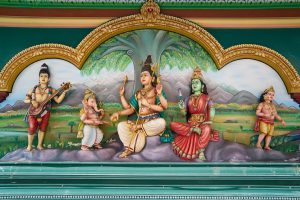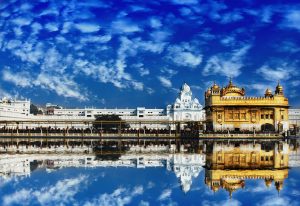India is known for its rich cultural and religious diversity. Presented below are five major religions in India, detailing their historical backgrounds, core beliefs, practices, and their influence on Indian society.
Hinduism
 Hinduism is one of the oldest religions in the world, with roots tracing back over 4,000 years. It originated in the Indian subcontinent and has evolved over millennia, influenced by various cultures and traditions.
Hinduism is one of the oldest religions in the world, with roots tracing back over 4,000 years. It originated in the Indian subcontinent and has evolved over millennia, influenced by various cultures and traditions.
Hinduism is not a monolithic religion but a complex, pluralistic system of beliefs and practices. Key beliefs include the concepts of Dharma (duty/ethics), Karma (action and subsequent reaction), Samsara (cycle of birth, death, and rebirth), and Moksha (liberation from the cycle of Samsara). Hindus believe in a supreme being called Brahman, who manifests in various forms, including deities like Vishnu, Shiva, and Devi.
Hindu practices vary widely but often include rituals (puja), meditation, yoga, pilgrimage (to sites like Varanasi and Rameswaram), and festivals (Diwali, Holi, Navratri). The caste system, though officially abolished, still influences social structures in many parts of India and in certain other countries where Hindus live.
Hinduism strongly shapes Indian culture, art, literature, and social norms. It influences dietary practices (many Hindus are vegetarians), festivals, and family structures. Hindu epics like the Mahabharata and Ramayana play a significant role in Indian literature and folklore.
Christianity

Christians believe in one God and follow the teachings of Jesus Christ as presented in the Bible. Key beliefs of mainstream Christianity include the Trinity (Father, Son, Holy Spirit), the resurrection of Jesus, salvation through faith, and the importance of love and compassion.
Christian practices include attending church services, prayer, reading the Bible, and participating in sacraments like baptism and communion. Major festivals include Christmas, Easter, and Good Friday.
Christianity has influenced Indian education (many schools and colleges are run by Christian missionary societies), healthcare (Christian hospitals), and social services. Christian festivals are celebrated with great enthusiasm, especially in regions like Kerala, Goa, and the North-East.
Islam
 Islam came to India in the 7th century through trade and later through invasions by Islamic rulers. It became firmly established with the Delhi Sultanate and the Mughal Empire.
Islam came to India in the 7th century through trade and later through invasions by Islamic rulers. It became firmly established with the Delhi Sultanate and the Mughal Empire.
Islam is a monotheistic religion centered on the belief in one God (Allah) and the teachings of the Prophet Muhammad as detailed in the Qur’an. The Five Pillars of Islam—Shahada (faith), Salat (prayer), Zakat (charity), Sawm (fasting during Ramadan), and Hajj (pilgrimage to Mecca)—are central to Islamic practice.
Indian Muslims observe the Five Pillars of Islam and celebrate festivals like Eid al-Fitr and Eid al-Adha. Friday prayers (Jumu’ah) are significant communal activities. Indian Islam has also incorporated some local traditions and practices.
Islam has significantly influenced Indian architecture (Taj Mahal, Qutb Minar), music, cuisine (biryani, kebabs), and language (many Urdu words are of Persian and Arabic origin). The Mughal period left a lasting legacy on Indian culture and societal structures.
Buddhism
 Buddhism was founded by Siddhartha Gautama (Buddha) in the 5th century BC in India. It spread rapidly across Asia but declined in India after the 12th century, only to revive later.
Buddhism was founded by Siddhartha Gautama (Buddha) in the 5th century BC in India. It spread rapidly across Asia but declined in India after the 12th century, only to revive later.
Buddhism centers on the Four Noble Truths and the Eightfold Path, which outline the nature of suffering and the path to liberation. Key concepts include Karma, Samsara, and Nirvana.
Buddhist practices include meditation, following ethical precepts, participating in monastic life, and celebrating festivals like Vesak. Stupas and monasteries serve as important religious centers.
Buddhism has had a significant historical influence on Indian culture, art, and philosophy. Buddhist principles have shaped Indian values of non-violence and compassion. Sites like Bodh Gaya, Sarnath, and Kushinagar are important pilgrimage destinations.
Sikhism
 Sikhism was founded in the Punjab region in the 15th century by Guru Nanak and developed through the teachings of ten successive Gurus, the last being Guru Gobind Singh.
Sikhism was founded in the Punjab region in the 15th century by Guru Nanak and developed through the teachings of ten successive Gurus, the last being Guru Gobind Singh.
Sikhism is monotheistic, emphasizing the belief in one God, equality of all humans, and the importance of truthful living. Key texts include the Guru Granth Sahib, which is the eternal Guru. Sikhs reject caste distinctions and ritualism.
Sikhs engage in daily prayers (Nitnem), community service (Seva), and participate in communal worship at Gurdwaras. The Five Ks (Kesh, Kangha, Kara, Kachera, and Kirpan) are articles of faith that Khalsa Sikhs must carry.
Sikhism has had a strong influence in Punjab and other regions. It promotes values of equality, social justice, and community service. The Golden Temple in Amritsar is a significant religious and cultural center. Sikh festivals like Vaisakhi and Gurpurab are widely celebrated.
Summary
India’s multifaceted identity is a product of centuries of religious coexistence and cultural synthesis. This pluralism is evident in the syncretic traditions, such as Sufism, which blends elements of Islam and Hinduism, and the shared celebration of festivals across religious communities. The Indian Constitution enshrines the principles of secularism and religious freedom, allowing diverse religious practices to flourish.
The intermingling of religious traditions has fostered a unique cultural scene where diversity is celebrated, and different communities contribute to the nation’s collective heritage. This religious plurality is a source of creativity, continually shaping India’s evolving identity and cultural narrative.